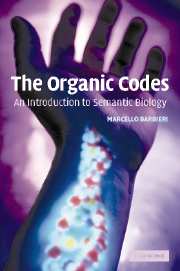Book contents
- Frontmatter
- Contents
- Foreword
- Dedication
- Acknowledgements
- Introduction
- Chapter 1 The microscope and the cell
- Chapter 2 Theories of evolution
- Chapter 3 A new model for biology
- Chapter 4 Organic codes and organic memories
- Chapter 5 The origin of life
- Chapter 6 Prokaryotes and eukaryotes
- Chapter 7 The Cambrian explosion
- Chapter 8 Semantic biology
- Chapter 9 A brief summary
- Appendix: Definitions of life
- Afterword
- References
- Index
Appendix: Definitions of life
Published online by Cambridge University Press: 23 November 2009
- Frontmatter
- Contents
- Foreword
- Dedication
- Acknowledgements
- Introduction
- Chapter 1 The microscope and the cell
- Chapter 2 Theories of evolution
- Chapter 3 A new model for biology
- Chapter 4 Organic codes and organic memories
- Chapter 5 The origin of life
- Chapter 6 Prokaryotes and eukaryotes
- Chapter 7 The Cambrian explosion
- Chapter 8 Semantic biology
- Chapter 9 A brief summary
- Appendix: Definitions of life
- Afterword
- References
- Index
Summary
(From Noam Lahav's Biogenesis, 1999; from Martino Rizzotti's Defining Life, 1996; and from personal communications by David Abel, Pietro Ramellini and Edward Trifonov, with permission).
Jean Baptiste LAMARCK (1802)
Life is an order or a state of things in the component parts of a body that makes organic movement possible and that effectively succeeds, as long as it persists, in opposing death.
Ludwig BÜCHNER (1855)
Spontaneous generation exists, and higher forms have gradually and slowly developed from previously existing lower forms, always determined by the state of the earth, but without immediate influence of a higher power.
Rudolf VIRCHOW (1855)
Life will always remain something apart, even if we should find out that it is mechanically aroused and propagated down to the minutest detail.
Ernst HAECKEL (1866)
Any detailed hypothesis concerning the origin of life must, as yet, be considered worthless, because up till now we have no satisfactory information concerning the extremely peculiar conditions which prevailed on the earth at the time when the first organisms developed.
Thomas Henry HUXLEY (1868)
The vital forces are molecular forces.
Justus von LIEBIG (1868)
We may only assume that life is just as old and just as eternal as matter itself … Why should not organic life be thought of as present from the very beginning just as carbon and its compounds, or as the whole of uncreatable and indestructible matter in general?
- Type
- Chapter
- Information
- The Organic CodesAn Introduction to Semantic Biology, pp. 255 - 264Publisher: Cambridge University PressPrint publication year: 2002



